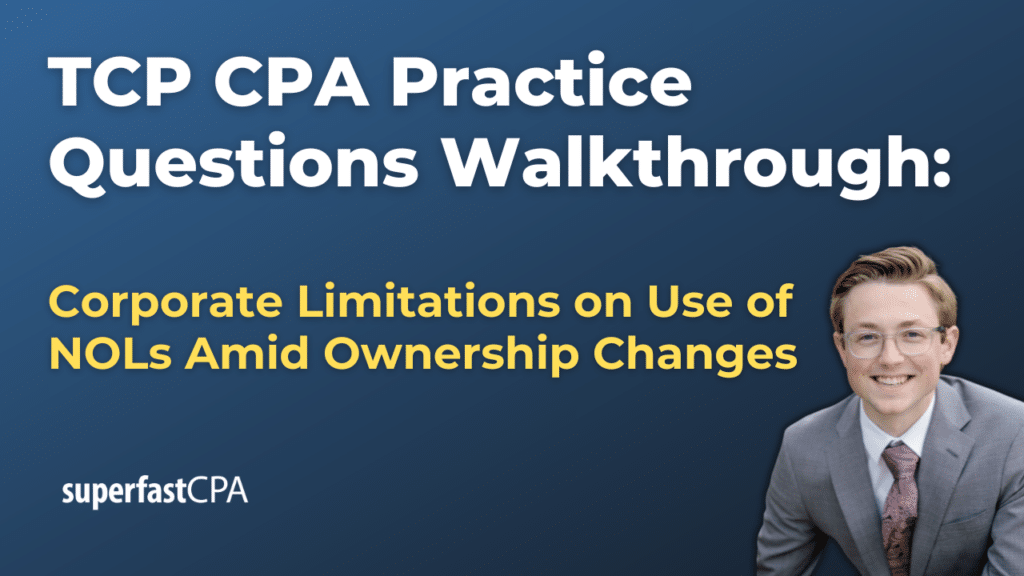In this video, we walk through 5 TCP practice questions teaching about the corporate limitations on use of NOLs amid ownership changes. These questions are from TCP content area 2 on the AICPA CPA exam blueprints: Entity Tax Compliance.
The best way to use this video is to pause each time we get to a new question in the video, and then make your own attempt at the question before watching us go through it.
Also be sure to watch one of our free webinars on the 6 “key ingredients” to an extremely effective & efficient CPA study process here…
Corporate Limitations on Use of NOLs Amid Ownership Changes
Net Operating Losses (NOLs) are a critical tax attribute for corporations, allowing them to offset taxable income in other periods. This provides a significant tax relief mechanism, particularly valuable for companies experiencing fluctuations in profitability. However, when there is a substantial change in the ownership of a corporation, certain limitations are imposed on the utilization of these NOLs to prevent potential abuse. These limitations are designed to ensure that the tax benefits associated with NOLs are not exploited disproportionately by new owners who did not generate the losses.
Definition of Ownership Change
An ownership change is defined as an increase of more than 50 percentage points in the ownership of the company’s stock by 5% shareholders within a specified testing period, typically three years. A 5% shareholder is any person or group that owns at least 5% of the corporation’s stock. The concept of ownership change triggers the limitations on NOL usage, ensuring that the losses cannot be freely transferred and used by new, unrelated owners.
Calculation of Annual Limitation
The annual limitation on the use of pre-change NOLs is calculated based on the fair market value of the loss corporation’s stock immediately before the ownership change, multiplied by a specified rate. This rate is often conceptualized as the long-term tax-exempt rate, reflecting what the corporation could earn if it invested its value in high-grade, tax-exempt securities. This calculation ensures that the use of NOLs is gradually phased in over time, preventing an immediate and substantial reduction in taxable income by the acquiring entity.
Built-in Gains and Losses
An important aspect of these limitations is the treatment of built-in gains and losses. Built-in gains are unrealized gains on assets that existed at the time of the ownership change. If these gains are recognized within five years of the ownership change, they can increase the annual limitation, thereby allowing the corporation to utilize more of its NOLs. Conversely, built-in losses recognized within the same period can further restrict the use of NOLs. This ensures a balanced approach, taking into account the pre-existing economic realities of the corporation’s assets.
Continuity of Business Enterprise (COBE) Requirement
To further safeguard against the exploitation of NOLs, the Continuity of Business Enterprise (COBE) requirement mandates that the corporation must continue to operate at least one significant historic business line or use a significant portion of its historic business assets. This requirement ensures that the corporation remains fundamentally the same business entity, thus preserving the intent that the NOLs were generated to support. It prevents new owners from merely acquiring the corporation for its tax attributes without continuing the underlying business operations.
Special Rules for Small Corporations
For small corporations, certain exemptions and relaxed requirements may apply. While these entities are still subject to the general limitations on NOLs, they may be exempt from some of the more detailed tracking requirements for changes in ownership among 5% shareholders. This recognizes the practical challenges small corporations face in maintaining detailed records and aims to simplify compliance without compromising the integrity of the tax rules.
Impact of Bankruptcy
In the context of bankruptcy, additional provisions may apply. If the ownership change occurs as part of a bankruptcy proceeding, and if the creditors and shareholders of the old loss corporation end up owning at least 50% of the new corporation, the annual limitation on the use of NOLs may be increased. This provision helps facilitate the reorganization and recovery of financially distressed companies by allowing greater use of their NOLs, providing a valuable tool for corporate turnaround efforts.
Interaction with Other Tax Attributes
The limitations on NOLs also extend to other tax attributes, such as capital loss carryovers and certain tax credits. This holistic approach ensures consistency in the application of the rules, preventing the selective exploitation of different types of tax attributes following an ownership change. It underscores the principle that tax benefits should reflect the economic realities of the corporation and not be artificially manipulated through changes in ownership.
Conclusion
The limitations on the use of NOLs amid ownership changes are designed to maintain the integrity of the tax system by ensuring that NOLs are used in a manner consistent with their original intent. These rules balance the need for corporations to utilize their tax attributes with the need to prevent tax avoidance through strategic ownership changes. By imposing calculated limitations and requirements such as COBE, these provisions help ensure that the benefits of NOLs are realized in a fair and economically justifiable manner.













